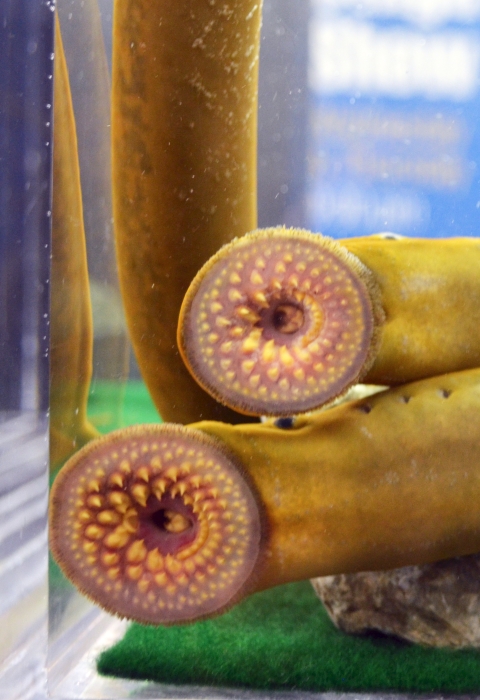About Us
Sea lampreys are a jawless parasitic fish native to the Atlantic Ocean. Invading the Great Lakes via manmade locks and shipping canals, their aggressive behavior and appetite for fish blood wreaked havoc on native fish populations. Sea lampreys decimated an already vulnerable lake trout fishery.
Marquette Biological Station was established by the U.S. Fish and Wildlife Service in 1956 to support sea lamprey research, monitoring and control efforts to fulfill U.S. obligations under the 1954 Convention on Great Lakes Fisheries between the United States and Canada and the Great Lakes Fishery Act of 1956. We work with state, tribal and other federal agencies to monitor progress towards fish community objectives for sea lampreys in each of the Great Lakes, but also to develop and implement actions to achieve these objectives. Activities are closely coordinated with state, tribal and other federal and provincial management agencies, non-government organizations, private landowners and the general public. Our primary goal is to conduct ecologically sound and publicly acceptable integrated sea lamprey control. Continued chemical treatments and use of barriers have resulted in increasingly healthier fish populations and an economic powerhouse fueled by the sport fishery. Sea lamprey control will continue to be important as lake trout restoration activities and lake sturgeon recovery efforts expand in the Great Lakes. Sea lamprey control is critical in the establishment of a diverse salmonine community and supporting sustainable harvests of walleye, rainbow smelt and trout, smallmouth bass, yellow perch and whitefish.
The Sea Lamprey Control Program is administered and funded by the Great Lakes Fishery Commission and implemented by two control agents, the U.S. Fish and Wildlife Service and Fisheries and Oceans Canada, who often partner on larger projects.
Our Mission
Marquette Biological Station was established by the U.S. Fish and Wildlife Service in 1956 to support the Sea Lamprey Control Program. Our primary goal is to conduct ecologically sound and publicly acceptable integrated sea lamprey control critical to the establishment of diverse and sustainable Great Lakes fish communities. Activities are closely coordinated with state, tribal and other federal and provincial management agencies, non-government organizations, private landowners and the general public.
Larval Population Assessment
Assessments are conducted to determine the presence, distribution, abundance and size structure of larval sea lampreys in Great Lakes tributaries and lentic or still water areas. In wadeable streams backpack electrofishers are used to assess larval sea lamprey populations. Larval populations in streams and lentic areas greater than one meter in depth are assessed using a granular lampricide.
Lampricide Control
Larval sea lamprey populations are controlled by applying federally registered lampricides to infested streams and lentic areas in the Great Lakes. Prior to each treatment, we collect water discharge and chemistry data. We use this data to determine the appropriate concentration of lampricide to apply. Lampricide concentrations are closely monitored in each stream to ensure larval sea lamprey populations are destroyed and non-target species mortality is minimized.
In the 1950s, the U.S. Fish and Wildlife Service sought to identify a chemical compound effective in controlling sea lampreys without significantly impacting other species. Scientists tested nearly 6,000 compounds in their research and discovered two compounds that were effective at controlling sea lampreys: one called TFM (3-trifluoromethyl-4'-nitrophenol), and the other Bayluscide (2', 5-dichloro-4'-nitrosalicylanilide). The lampricides have been used successfully for more than 60 years to suppress sea lamprey populations in the Great Lakes. By the early 1960s, the abundance of sea lampreys was reduced by 90%. This effort paved the way for the rehabilitation of a healthy Great Lakes ecosystem including the recovery of self-sustaining populations of native fish, such as lake trout, in portions of the Great Lakes.
Adult Population Assessment
Traps and nets are operated in about 40 tributaries in the Great Lakes during the spring and early summer to capture adult sea lampreys. A proportion of trapped sea lampreys are marked and released as a method of estimating an index of sea lamprey abundance for each Great Lake.
Barriers
There are more than 30 barriers on U.S. Great Lake streams that block migrating sea lampreys. Agents work with partners to maintain and implement barrier structures in streams to provide control when other options are not feasible, excessively expensive or ineffective.
Risk Management
Risk management activities are conducted to address environmental and non-target issues related to the implementation of sea lamprey control in the United States. Coordination with many federal, state and tribal agencies and working with others is critical to minimize risk to non-target organisms. Section 7 Section 7
Section 7 Consultation
The Endangered Species Act (ESA) directs all Federal agencies to work to conserve endangered and threatened species and to use their authorities to further the purposes of the Act. Section 7 of the Act, called "Interagency Cooperation," is the mechanism by which Federal agencies ensure the actions they take, including those they fund or authorize, do not jeopardize the existence of any listed species.
Learn more about Section 7 of the Endangered Species Act mandates that the Sea Lamprey Control Program consult with the U.S. Fish and Wildlife Service’s Ecological Services Program to ensure that federally funded actions authorized, permitted or otherwise carried out will not jeopardize the continued existence of any federally listed species, including those that are endangered, threatened or candidates, or adversely modify designated critical habitat.
Endangered species reviews are conducted annually to:
- Discuss the proposed lampricide applications and electrofishing surveys
- Assess the potential risk of these actions to listed species
- Develop procedures to protect and avoid disturbance for each listed species
- Conducted studies to determine the effect of an action on a species of concern when information is lacking
Research
The program also supports research designed to increase the efficiency of current methods or to advance new methods of controlling sea lampreys, such as:
- Use of attractants and repellents to guide sea lamprey towards traps or away from suitable habitats
- Environmental and physiological determination of sea lamprey sensitivity to lampricides
- Novel barrier designs that can block sea lampreys while addressing fish passage fish passage
Fish passage is the ability of fish or other aquatic species to move freely throughout their life to find food, reproduce, and complete their natural migration cycles. Millions of barriers to fish passage across the country are fragmenting habitat and leading to species declines. The U.S. Fish and Wildlife Service's National Fish Passage Program is working to reconnect watersheds to benefit both wildlife and people.
Learn more about fish passage and human safety objectives - Improving selective fish passage by exploiting behavioral and physiological traits of desired and undesirable species
- Identifying supplemental control techniques that can be deployed to reduce or eliminate the use of lampricides
Our History
1956 - Marquette Biological Station was established in Marquette, Michigan.
Other Facilities in this Complex
Marquette Biological Station and Ludington Biological Station work together to deliver the Sea Lamprey Control Program in the U.S. waters of the Great Lakes.

